Moment Redistribution in UHPC Continuous Beams Reinforced with High-Strength Steel Bars: Numerical Investigation and Prediction Model
Abstract
:1. Introduction
2. Finite Element Modeling and Implementation
2.1. Establishment of Finite Element Model
2.1.1. Element Types and Meshing
2.1.2. Material Constitutive Relationships
2.1.3. Boundary Conditions and Interaction Properties
2.2. Model Verification
Load-Displacement Curve
3. Finite Element Analysis of Moment Redistribution in Continuous UHPC Beams with High Strength Reinforcement
3.1. Model Design
3.2. Analysis of Results
3.2.1. Analysis of Damage Patterns
3.2.2. Load-Displacement Curve of UHPC Continuous Beams
3.2.3. Support Reaction Forces of UHPC Continuous Beams
3.2.4. Strain Analysis of Longitudinal Steel Bars in UHPC Continuous Beams
3.2.5. The Whole Process of Moment Redistribution in UHPC Continuous Beams
4. Parameter Analysis
4.1. Effect of UHPC Strength Grade fcu
4.2. Effect of Strength Grade of Reinforcement fy
4.3. Effect of Neutral Axis Depth Factor c/d
4.4. Effect of Beam Depth d
4.5. Effect of Span–Depth Ratio l/d
4.6. Effect of Ratio of Longitudinal Reinforcement Ratio between the Mid-Span and Intermediate Support η
4.7. Effect of Load Form
5. Establishment of Prediction Model
6. Comparison of Moment Redistribution in NC Continuous Beams and UHPC Continuous Beams
7. Conclusions
- (1)
- For the nine UHPC simulated continuous beams, the simulated values of the intermediate support reaction and end support reaction gradually deviated from those of the elastic theoretical values with the increase in load, indicating that moment redistribution in high-strength reinforced UHPC continuous beams occurs during the whole process of loading. Moreover, the development of moment redistribution was relatively gentle and long before the formation of plastic hinges, of which the degrees were considerable, accounting for 22.2~29.6% of the total moment redistribution. After the formation of the plastic hinges, a rapid increase in the degree of moment redistribution could be captured with the rotation of the plastic hinges. Therefore, two-stage moment redistribution was proposed, namely, elastic moment redistribution and plastic moment redistribution.
- (2)
- The elastic moment redistribution initiated from UHPC reaching tensile plasticity and evolved with the development of concrete cracks. An increase in the yield strength of the reinforcement and the ratio of the reinforcement between the mid-span and intermediate support led to a higher degree of elastic moment redistribution. Moreover, increasing the neutral axis depth factor, concrete compressive strength, span-to-depth ratio, and beam depth had an adverse effect on elastic moment redistribution.
- (3)
- The plastic hinges were first formed at the intermediate support regions where the tensile rebar strains exhibited a concentrated increase. With an increase in the neutral axis depth factor, the plastic hinge lengths and rotations decreased, leading to a decrease in plastic moment redistribution. Additionally, the degrees of plastic moment redistribution decreased with the increase in the span-to-depth ratio and yield strength of the reinforcement.
- (4)
- Based on the above parametric finite element analysis results, formulas for calculating the degrees of elastic and plastic moment redistribution were established for high-strength reinforced UHPC continuous beams under different loading conditions using each key parameter as an independent variable.
- (5)
- Compared to normal concrete beams in identical conditions, the elastic moment distribution in UHPC two-span continuous beams was comparatively smaller while the plastic moment distribution was relatively larger. Overall, due to the high ductility of UHPC, the degrees of the total moment distribution in UHPC structures were greater than those of normal concrete structures.
Author Contributions
Funding
Data Availability Statement
Conflicts of Interest
References
- Roy, D.M. Advanced cement systems including CBC, DSP, MDF. In Proceedings of the 9th International Congress on the Chemistry of Cement, New Delhi, India, 1992; Volume 1, pp. 357–380. [Google Scholar]
- Sedran, F.D.L. Optimization of ultra-high-performance concrete by the use of a packing model. Cem. Concr. Res. 1994, 24, 997–1009. [Google Scholar]
- Xu, M.; Liang, X.; Wang, P.; Wang, Z. Theoretical investigation on normal section flexural capacity of uhpc beams. Eng. Mech. 2019, 36, 70–78. [Google Scholar]
- Azmee, N.M.; Shafiq, N. Ultra-high performance concrete: From fundamental to applications. Case Stud. Constr. Mater. 2018, 9, e00197. [Google Scholar] [CrossRef]
- Sohail, M.G.; Kahraman, R.; Al Nuaimi, N.; Gencturk, B.; Alnahhal, W. Durability characteristics of high and ultra-high performance concretes. J. Build. Eng. 2021, 33, 101669. [Google Scholar] [CrossRef]
- Abushanab, A.; Alnahhal, W.; Sohail, M.G.; Alnuaimi, N.; Kahraman, R.; Altayeh, N. Mechanical and durability properties of ultra-high performance steel FRC made with discarded materials. J. Build. Eng. 2021, 44, 103264. [Google Scholar] [CrossRef]
- Zhang, Y.; Zhu, Y.; Yeseta, M.; Meng, D.; Shao, X.; Dang, Q.; Chen, G. Flexural behaviors and capacity prediction on damaged reinforcement concrete (RC) bridge deck strengthened by ultra-high performance concrete (UHPC) layer. Constr. Build. Mater. 2019, 215, 347–359. [Google Scholar] [CrossRef]
- Zhu, Y.; Zhang, Y.; Hussein, H.H.; Chen, G. Numerical modeling for damaged reinforced concrete slab strengthened by ultra-high performance concrete (UHPC) layer. Eng. Struct. 2019, 209, 110031. [Google Scholar] [CrossRef]
- Shaikh, F.U.A.; Luhar, S.; Arel, H.Ş.; Luhar, I. Performance evaluation of ultra high performance fiber reinforced concrete—A review. Construct. Build. Mater. 2020, 232, 117152. [Google Scholar] [CrossRef]
- Wu, Z.; Shi, C.; He, W.; Wang, D. Uniaxial Compression Behavior of Ultra-High Performance Concrete with Hybrid Steel Fiber. J. Mater. Civ. Eng. 2016, 28, 06016017. [Google Scholar] [CrossRef]
- Aboukifa, M.; Moustafa, M.A. Experimental seismic behavior of ultra-high performance concrete columns with high strength steel reinforcement. Eng. Struct. 2021, 232, 111885. [Google Scholar] [CrossRef]
- Aydogan, M.S.; Alacali, S.; Arslan, G. Prediction of moment redistribution capacity in reinforced concrete beams using gene expression programming. Structures 2023, 47, 2209–2219. [Google Scholar] [CrossRef]
- EN 1992-1-1-2011; Eurocode 2: Design of Concrete Structures: Part 1-1: General Rules and Rules for Buildings. European Committee for Standardization: Brussels, Belgium, 2011.
- AS 3600-2018; Concrete Structures. Australia Standards: Sydney, Australia, 2018.
- BS 8110-1:1997; Structure Use of Concrete. British Standards Institution: London, UK, 1997.
- DIN 1045-3; Concrete Reinforced and Prestressed Concrete Structures. German Institute of Standard (Deutesches Institut fur Normung): Berlin, Germany, 2008.
- CSA A23.3-19; Design of Concrete Structures. Canadian Standards Association: Toronto, ON, Canada, 2019.
- ACI 318-19; Building Code Requirements for Structural Concrete. American Concrete Institute: Farmington Hills, MI, USA, 2019.
- CECS 51:93; Design Code for Reinforced Concrete Continuous Beams and Frames Considering Redistribution of Internal Forces. China Planning Press: Beijing, China, 1993.
- Zhao, G.Y.; Wu, J.G. Study on the limit of bending moment modulation in reinforced concrete continuous beams. Build. Struct. 1982, 37–42. [Google Scholar]
- Li, L.; Wang, K.Y.; Wang, Y. Study on bending moment modulation of high-strength reinforced concrete continuous beams. J. Build. Struct. 2018, 39, 263–271. [Google Scholar]
- Xu, J. Study on Reasonable Values of Moment Modulation Coefficients for Reinforced Concrete Frame Beams. Master’s Thesis, Huazhong University of Science and Technology, Wuhan, China, 2013. [Google Scholar]
- Kheyroddin, A.; Naderpour, H. Plastic hinge rotation capacity of reinforced concrete beams. Int. J. Civ. Eng. 2007, 5, 30–47. [Google Scholar]
- Scott, R.H.; Whittle, R.T. Moment redistribution effects in beams. Mag. Concr. Res. 2005, 57, 9–20. [Google Scholar] [CrossRef]
- Mostofinejad, D.; Farahbod, F. Parametric study on moment redistribution in continuous RC beams using ductility demand and ductility capacity concept. Iran. J. Sci. Technol. 2007, 31, 459. [Google Scholar]
- Li, L.; Li, B.; Guo, N.; Zheng, W. Experimental and numerical investigations on moment redistribution in reinforced concrete frames subjected to vertical loads. Eng. Struct. 2022, 261, 114289. [Google Scholar] [CrossRef]
- Hibbitt, H.D.; Karlsson, B.I.; Sorensen, E.P. ABAQUS User’s Manual; Dassault Systemes Simulia Corp.: Providence, RI, USA, 2011. [Google Scholar]
- Guo, X.Y.; Kang, J.F.; Zhu, J.S. Uniaxial Compression Constitutive Relation of Ultra-High-Performance Concrete. J. Southeast Univ. 2017, 47, 369–376. [Google Scholar]
- Su, J.Z.; Fu, Y.F.; Huang, Q.W. Bending test and finite element analysis study of reinforced ultra-high performance concrete beams. Sino-Foreign Highw. 2017, 0379, 99–105. [Google Scholar]
- Lu, X.Z.; Jiang, J.J. Nonlinear finite element analysis of spatial forces in prestressed steel-concrete composite two-way floor slabs. Ind. Archit. 2003, 33, 57–59. [Google Scholar]
- Li, L.; Zheng, W.Z. Tests on plastic properties of continuous beams of reactive powder concrete. J. Harbin Inst. Technol. 2010, 42, 193–199. [Google Scholar]
- GB 50010-2010; Code for Design of Concrete Structures. China Construction Industry Press: Beijing, China, 2010.
- Li, L. Study of moment redistribution in continuous beams and frames with high-strength hot-rolled steel bars as tensile longitudinal bars. Harbin Inst. Technol. 2019. [Google Scholar] [CrossRef]
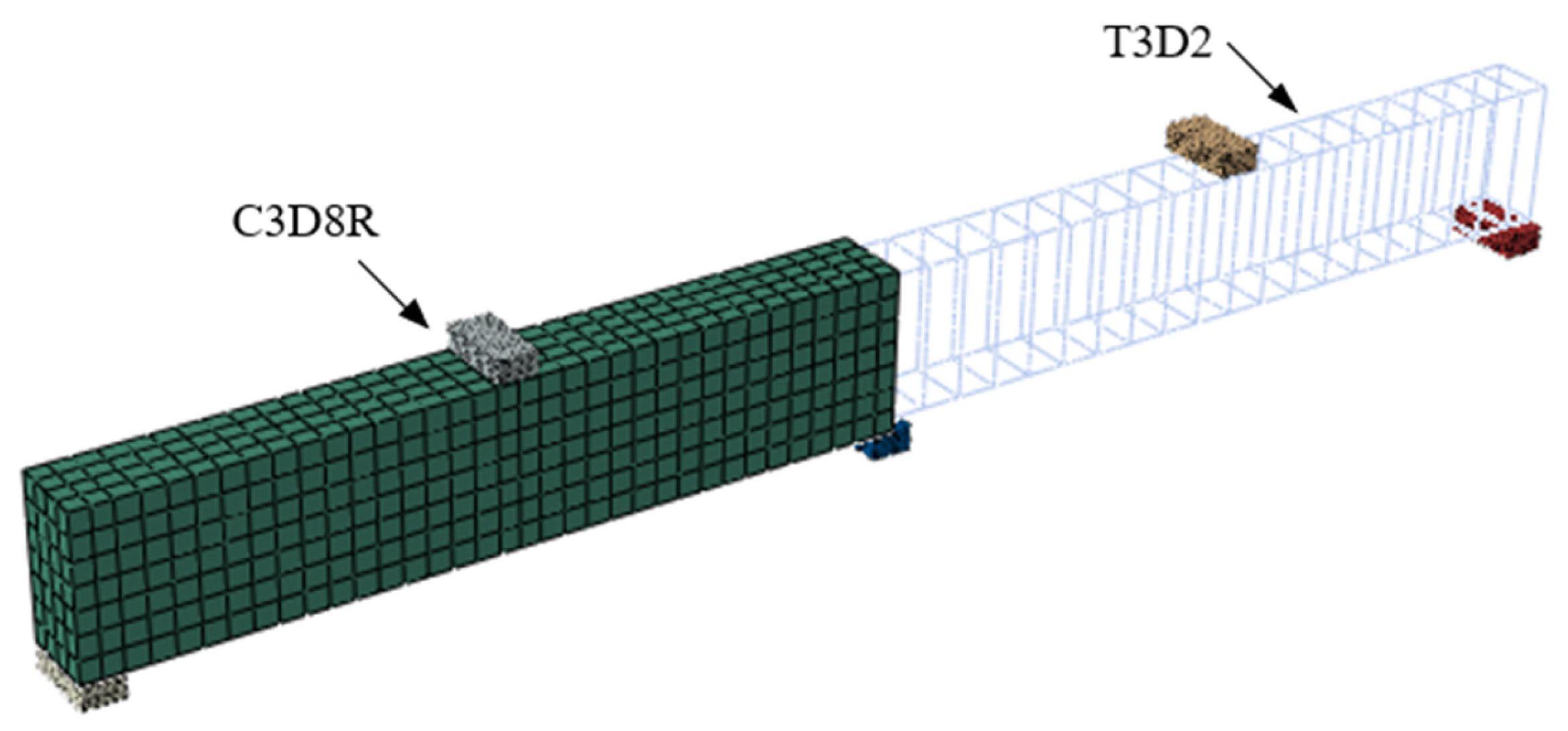
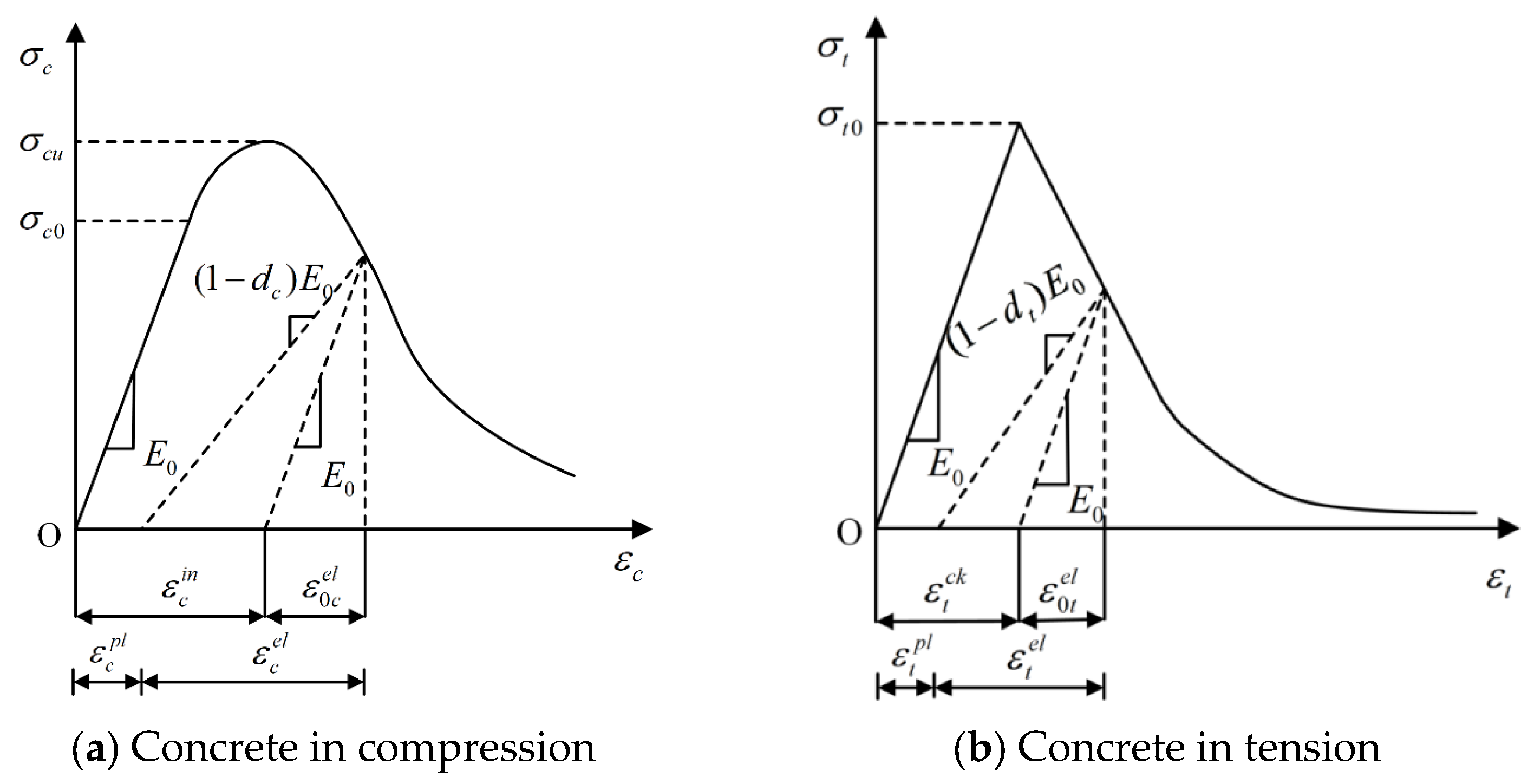
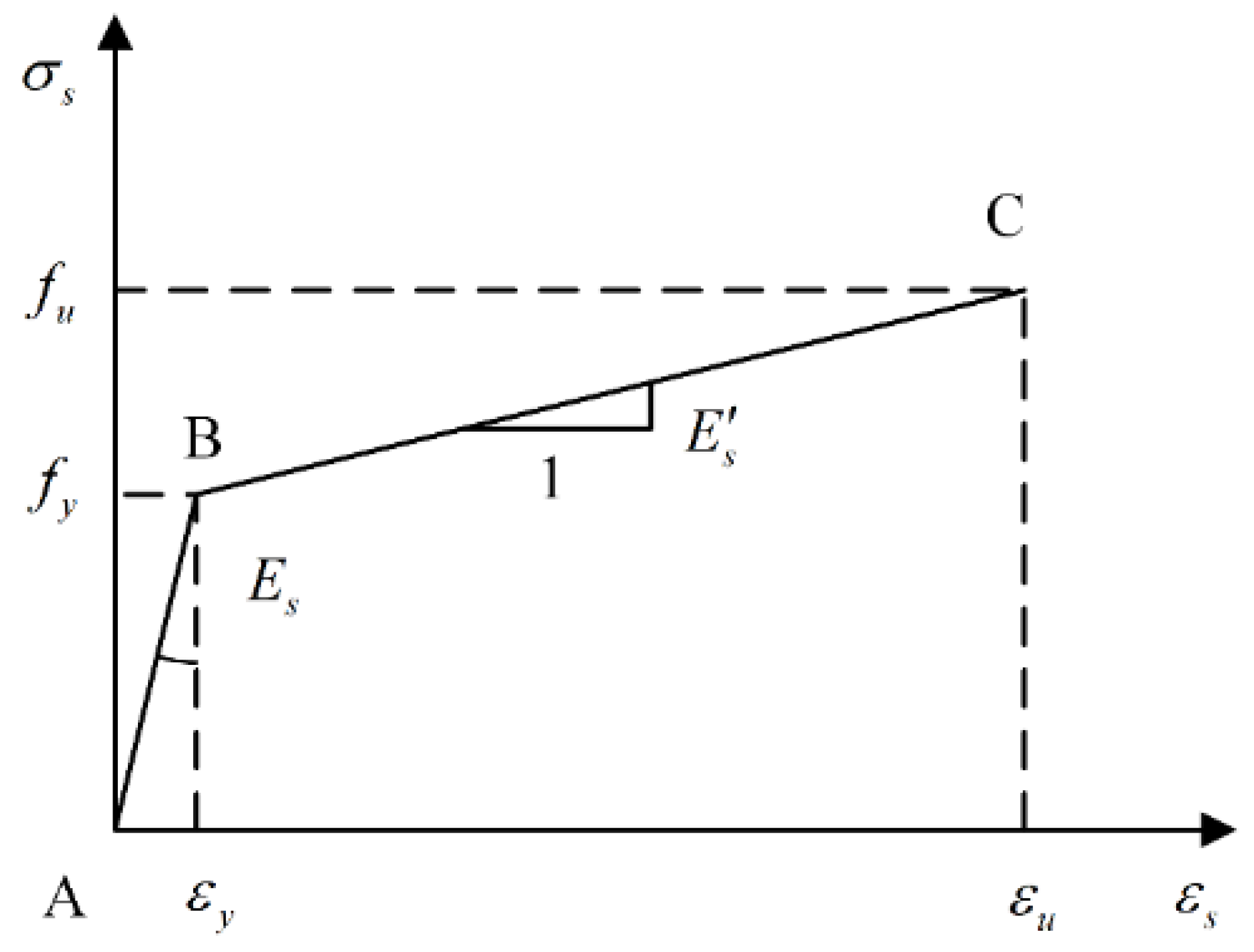

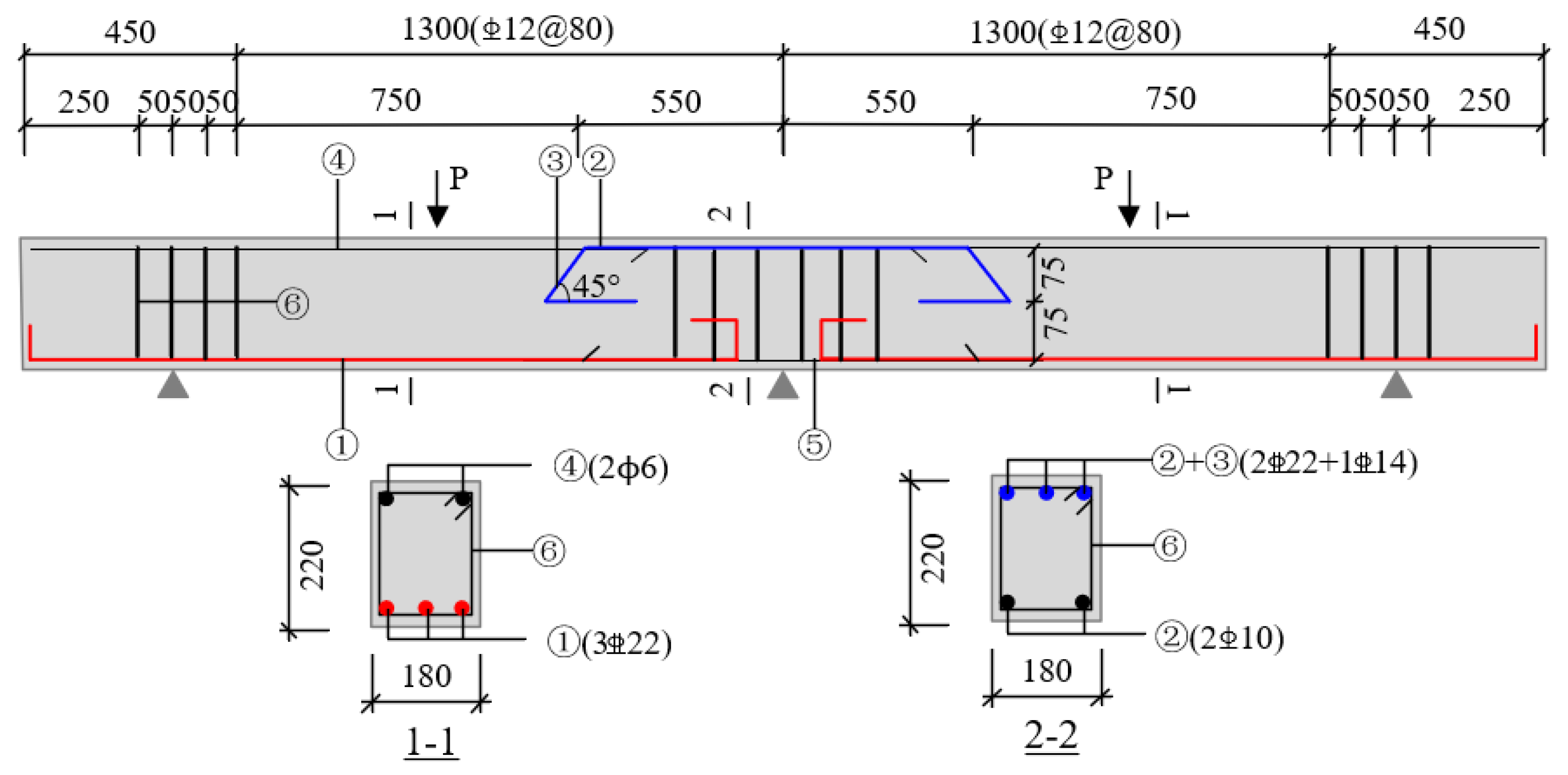



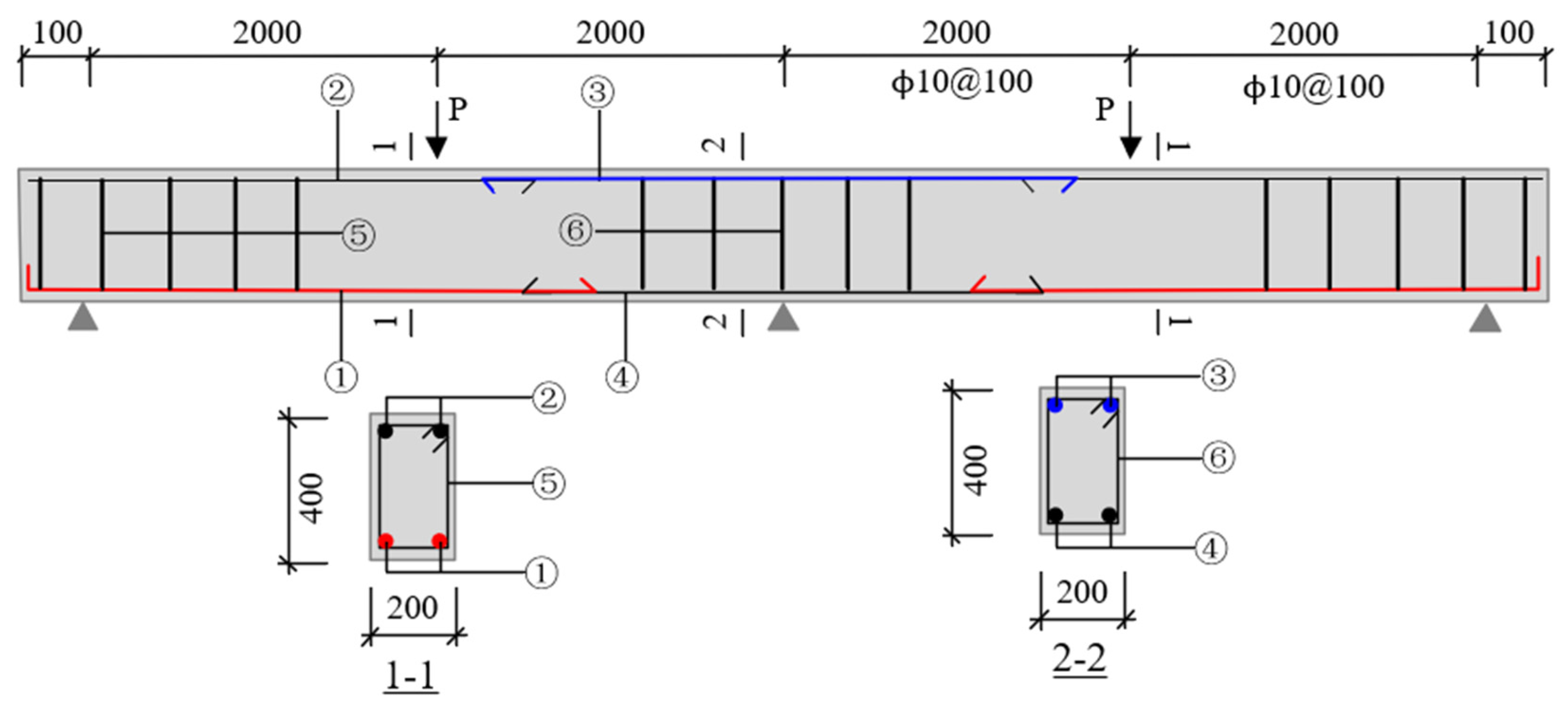





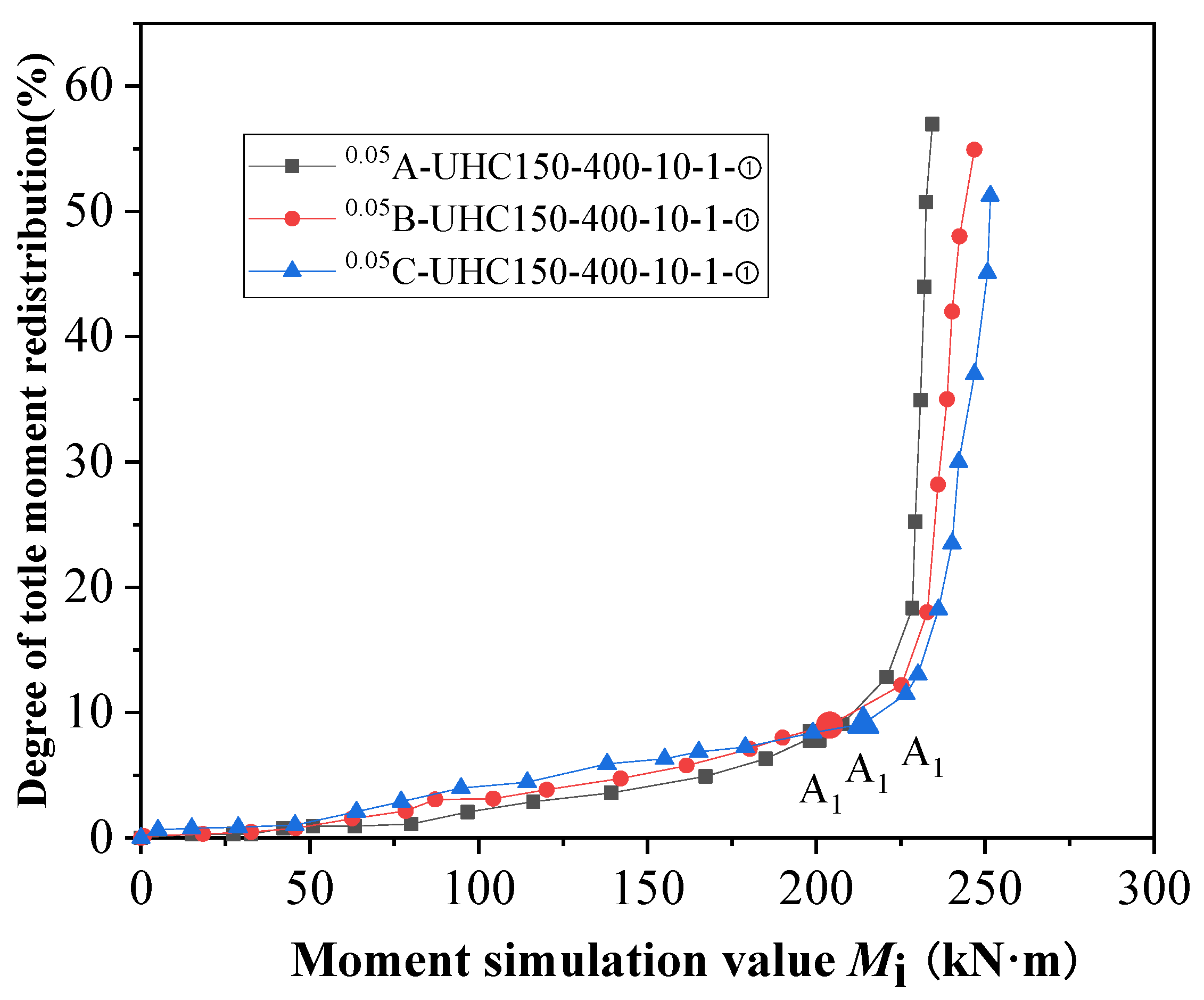
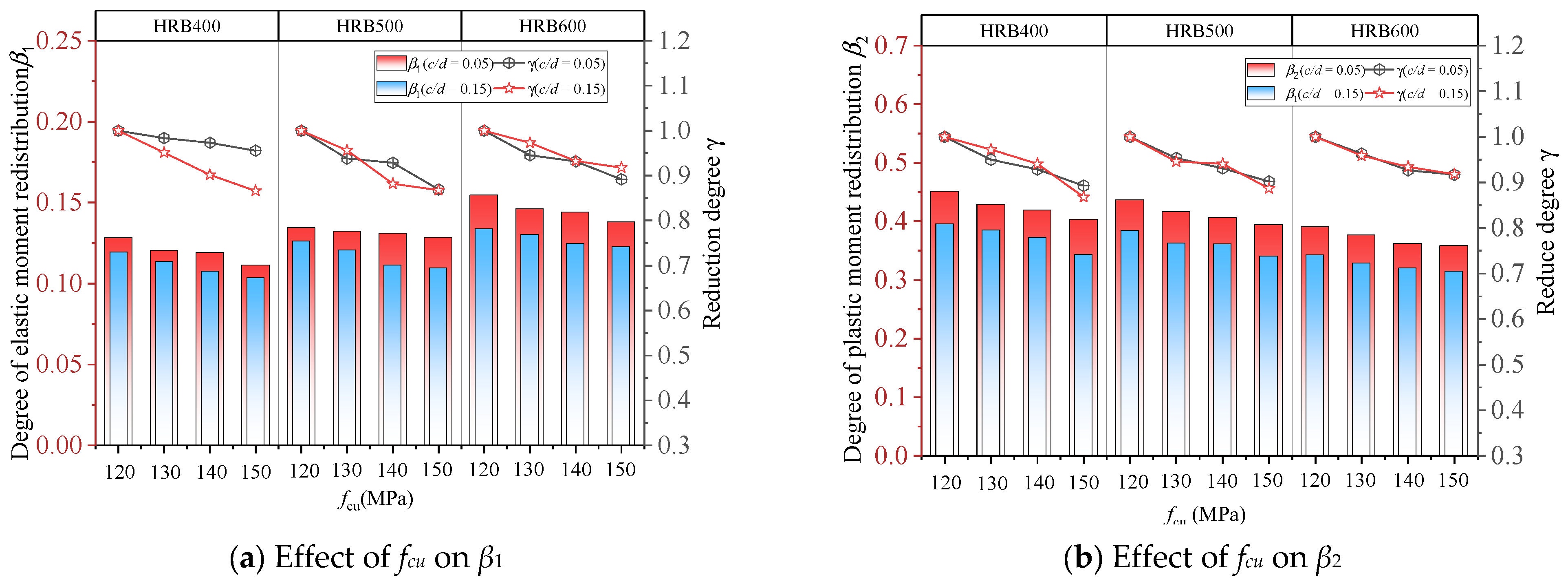
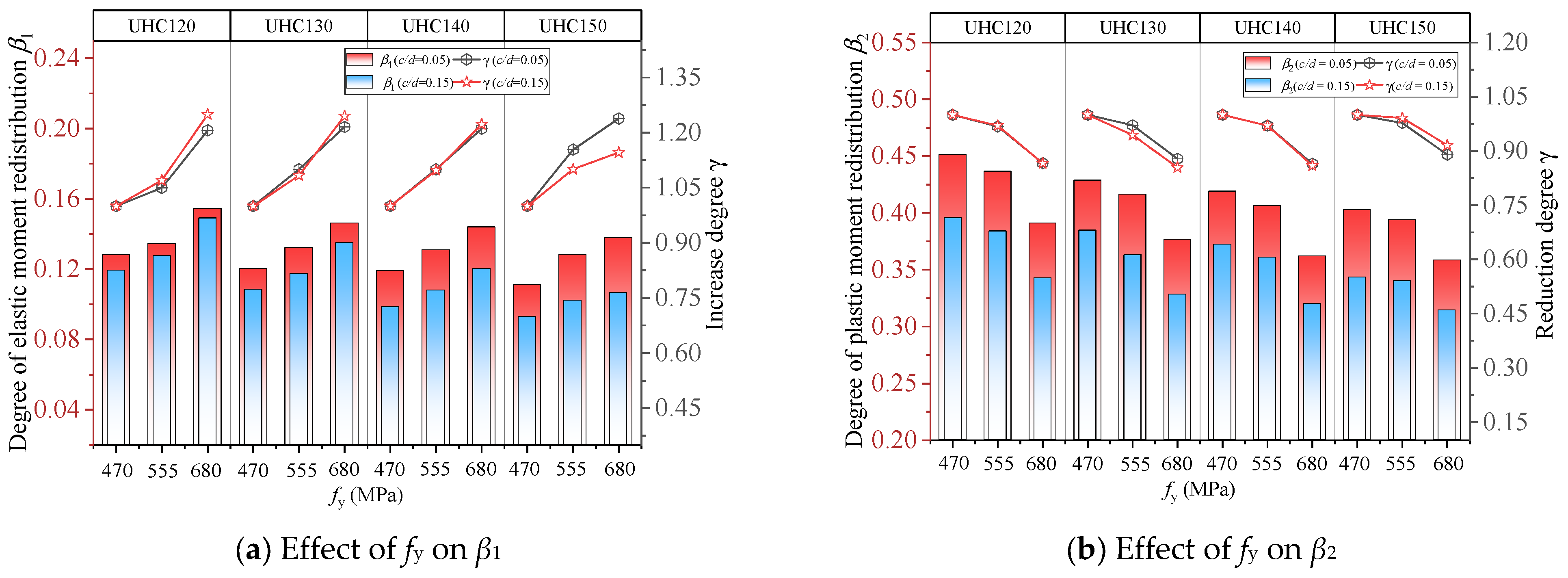
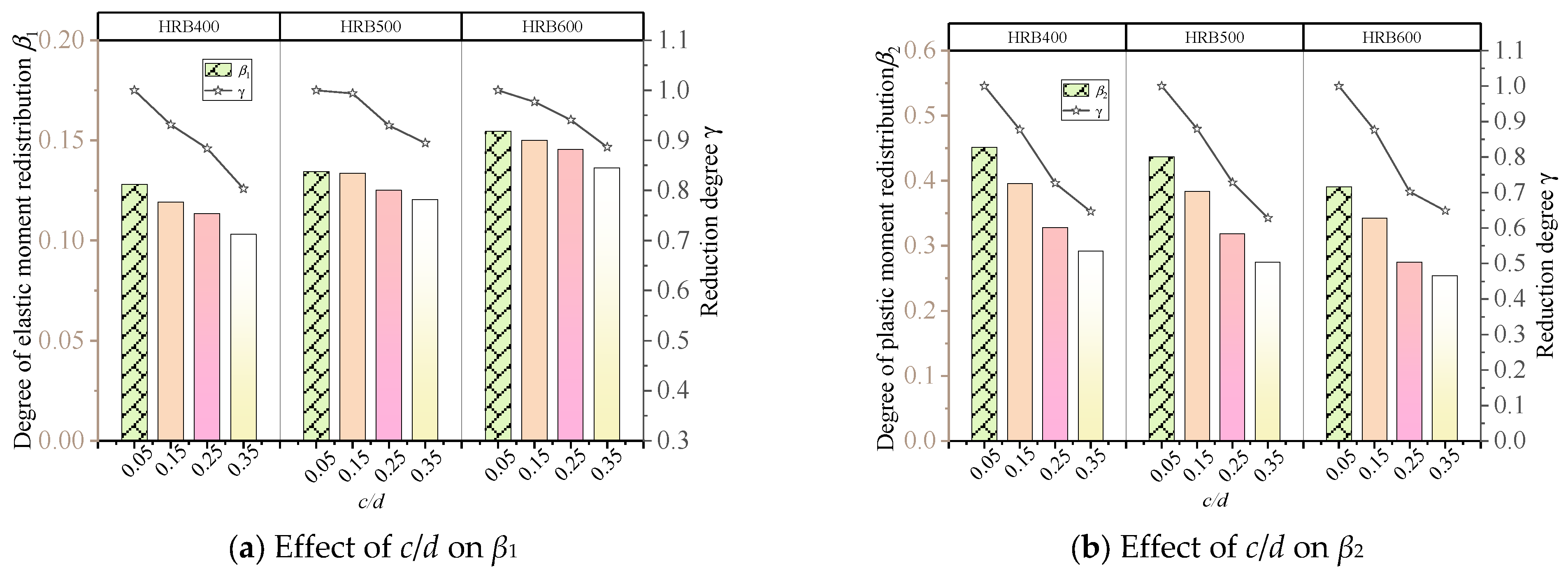
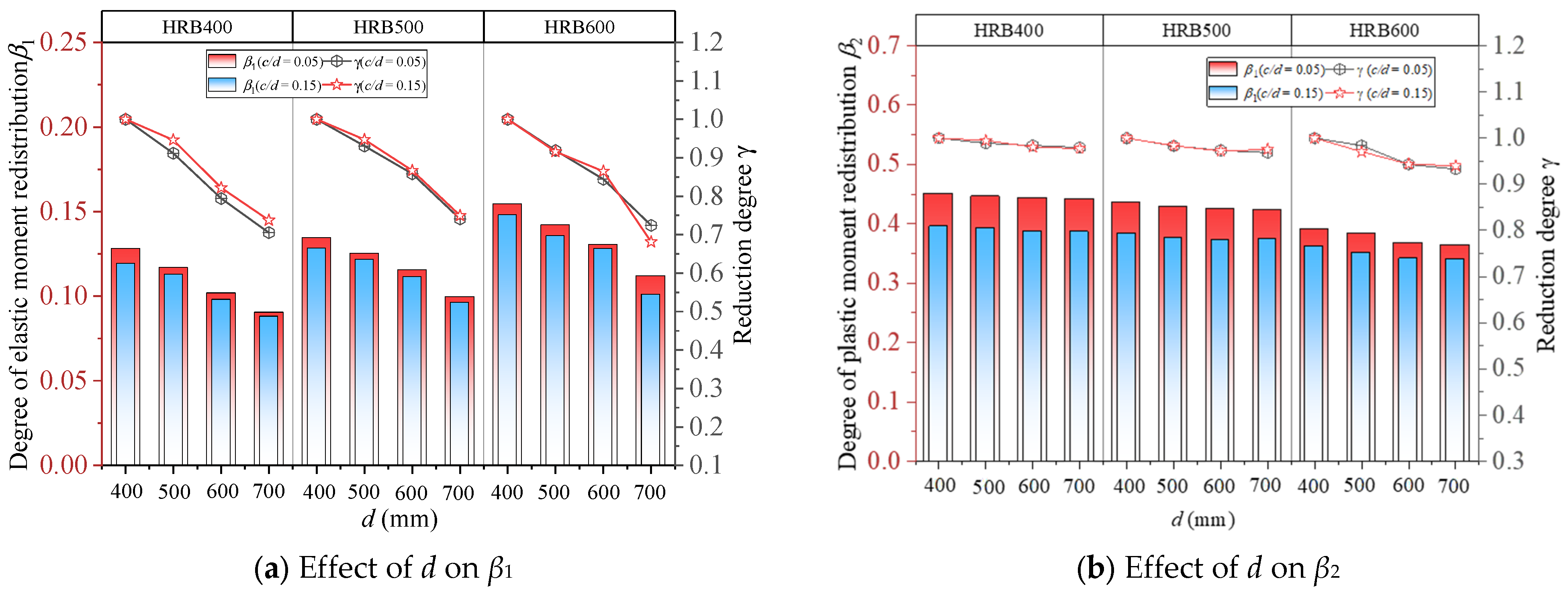
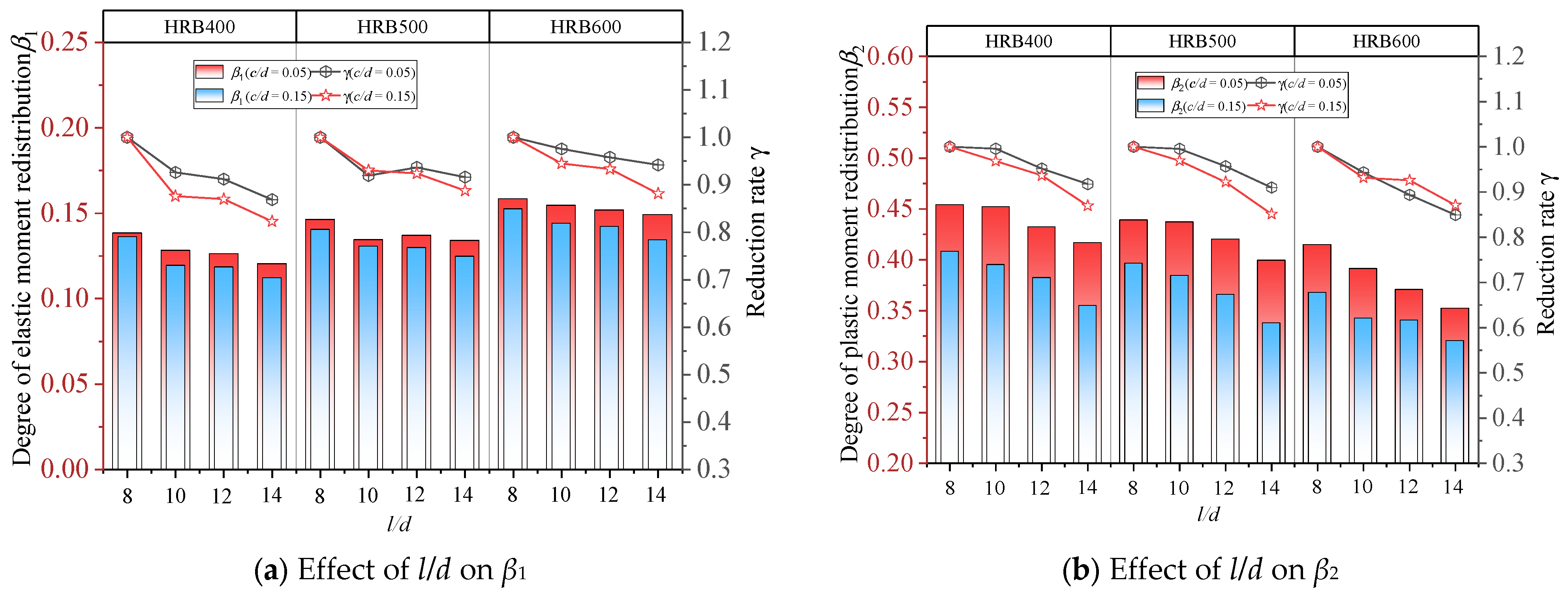
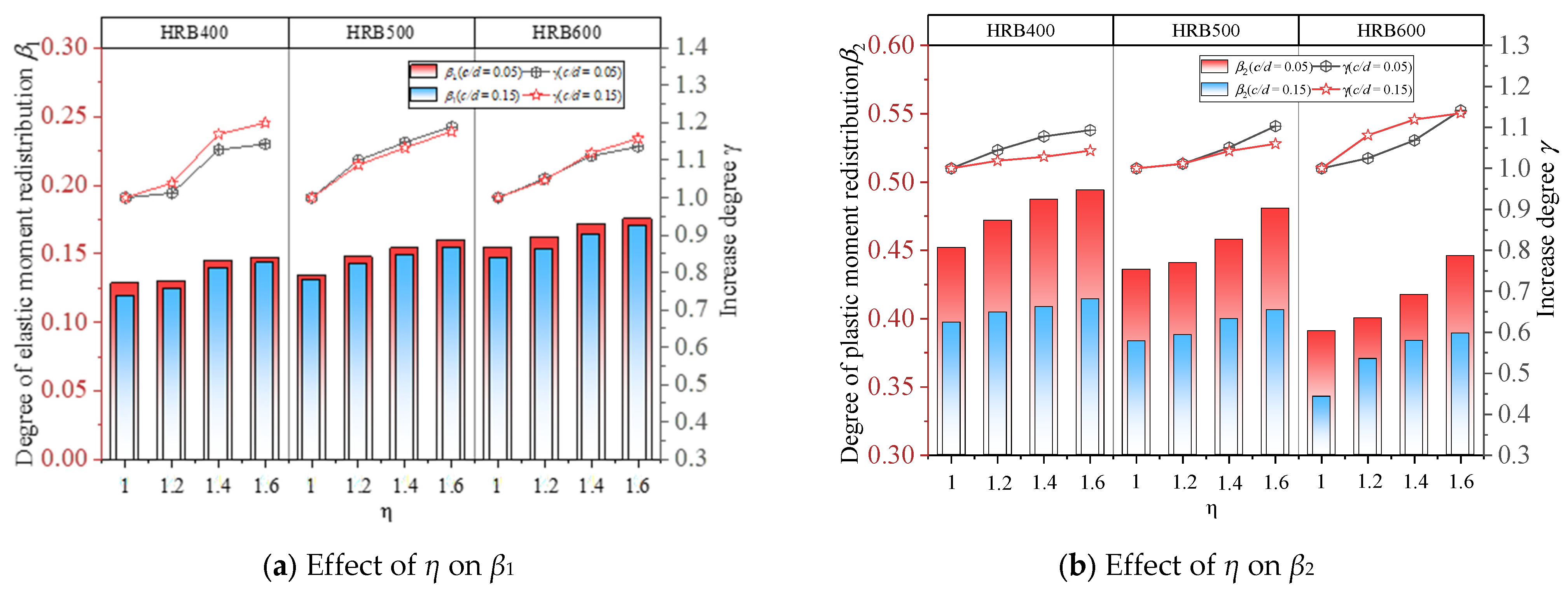

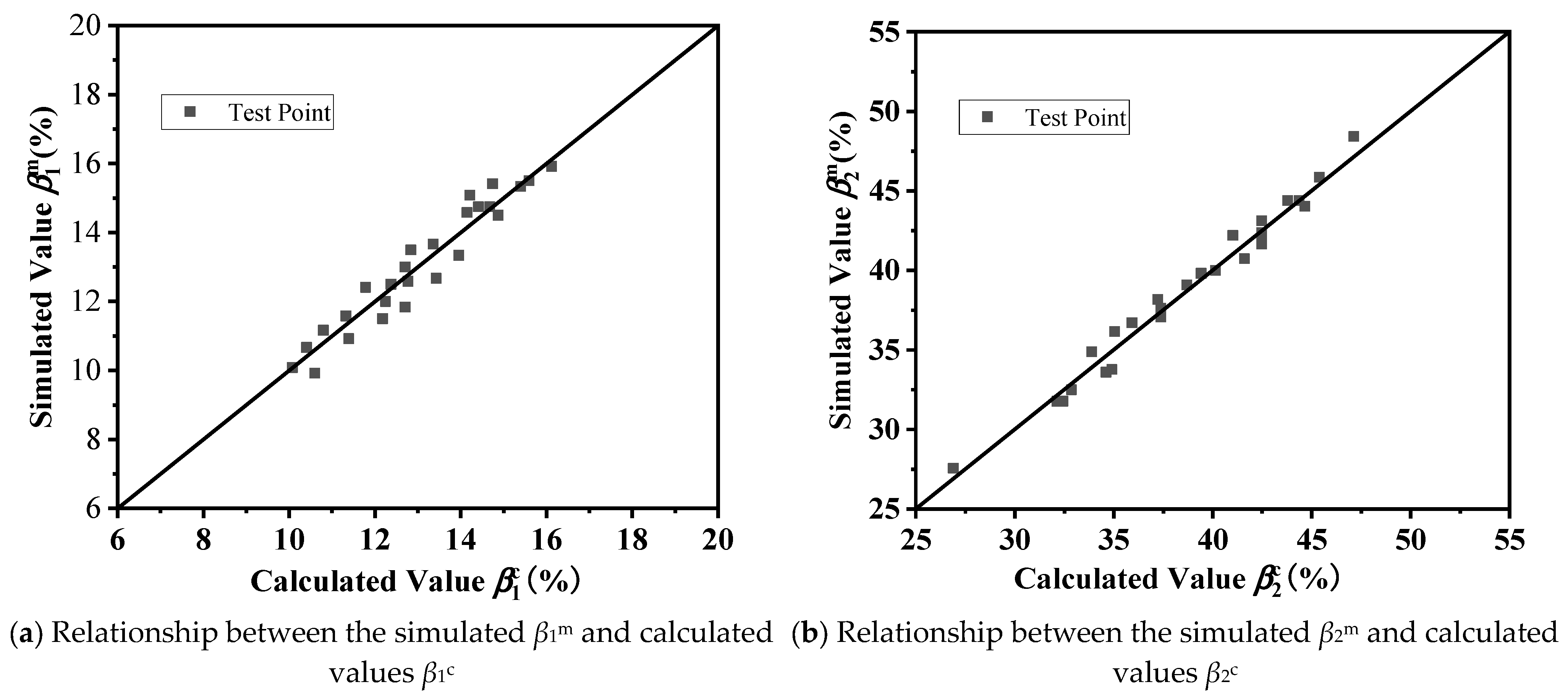

| fc | fy | c/d | d | l/d | η | Loading Form | |
|---|---|---|---|---|---|---|---|
| D Farahbod F et al. (2007) [25] | ✓ | ✓ | ✓ | ||||
| Zhao G Y et al. (1982) [20] | |||||||
| Li L et al. (2018) [21] | ✓ | ✓ | ✓ | ✓ | ✓ | ||
| Xu J et al. (2013) [22] | ✓ | ✓ | ✓ | ✓ | ✓ | ||
| Kheyroddin A et al. (2007) [23] | ✓ | ✓ | |||||
| Scott R H et al. (2005) [24] | ✓ | ✓ | |||||
| EN 1992-1-1:2011 [13] | ✓ | ✓ | ✓ | ||||
| AS 3600-2018 [14] | ✓ | ||||||
| BS 8100-1:97 [15] | ✓ | ||||||
| DIN 1045-3: 2008 [16] | ✓ | ✓ | ✓ | ||||
| CSA-A23.3-19 [17] | ✓ | ||||||
| ACI 318-19 [18] | ✓ | ||||||
| CECS 51-93 [19] | ✓ |
| ψ | e | σb0/σb0 | Kc | μ |
|---|---|---|---|---|
| 36° | 0.1 | 1.16 | 0.6667 | 0.001 |
| Specimens No. | Beam Length (mm) | Section Size (mm) | Longitudinal Steel Bars in Intermediate Support | Mid-Span Longitudinal Bars | Stirrups |
|---|---|---|---|---|---|
| LL-1 | 3400 | 180 × 220 | 1 14 + 2 14 + 2 22 22 | 3 22 22 |  12@80 12@80 |
| LL-2 | 3400 | 180 × 220 | 2 22 22 | 3 22 22 |  12@80 12@80 |
| LL-3 | 3400 | 180 × 220 | 2 18 18 | 3 22 22 |  12@80 12@80 |
| LL-4 | 3400 | 180 × 220 | 2 14 14 | 3 22 22 |  12@80 12@80 |
| LL-5 | 3400 | 180 × 220 | 2 10 10 | 3 22 22 |  12@80 12@80 |
 ,
,  , and
, and  are HPB235, HRB335, and HRB400 grade steel bars according to the Code for the design of concrete structures [32].
are HPB235, HRB335, and HRB400 grade steel bars according to the Code for the design of concrete structures [32].| Compressive/Tensile Strength (MPa) | Elastic Modulus (MPa) | Peak Strain (με) | Ultimate Strain (με) | |
|---|---|---|---|---|
| Compression | 102 | 41,237 | 3560 | 5500 |
| Tension | 10.19 | — | 249 | — |
| Rebar |  6 6 |  10 10 |  12 12 |  14 14 |  18 18 |  22 22 |
|---|---|---|---|---|---|---|
| Yield strength fy (N·mm−2) | 275.0 | 356.0 | 364.0 | 476.5 | 467.6 | 478.3 |
| Ultimate strength fu (N·mm−2) | 310.5 | 560.0 | 578.0 | 615.6 | 624.7 | 613.2 |
| Yield strain εy (με) | 1310 | 1756 | 2401 | 2100 | 2380 | 2163 |
| Specimens No. | Test Value in Left Span PuL (kN) | Test Value in Right Span PuR (kN) | Value of Simulation Ps (kN) | Maximum Error (%) |
|---|---|---|---|---|
| LL-1 | 348 | 360 | 363 | 4.31 |
| LL-2 | 317 | 342 | 344 | 8.52 |
| LL-3 | 301 | 322 | 322 | 6.98 |
| LL-4 | 300 | 263 | 303 | 15.21 |
| LL-5 | 285 | 285 | 295 | 3.51 |
| Specimen | Steel Grade | c/d | Area of Longitudinal Reinforcement for Center Support AS1 (mm2) | Area of Longitudinal Reinforcement in Span AS2 (mm2) |
|---|---|---|---|---|
| 0.05A-UHC150-400-10-1-① | HRB400 | 0.05 | 506 | 506 |
| 0.05B-UHC150-400-10-1-① | HRB500 | 0.05 | 405 | 405 |
| 0.05C-UHC150-400-10-1-① | HRB600 | 0.05 | 337 | 337 |
| 0.15A-UHC150-400-10-1-① | HRB400 | 0.15 | 2293 | 2293 |
| 0.15B-UHC150-400-10-1-① | HRB500 | 0.15 | 1836 | 1836 |
| 0.15C-UHC150-400-10-1-① | HRB600 | 0.15 | 1577 | 1577 |
| 0.25A-UHC150-400-10-1-① | HRB400 | 0.25 | 3965 | 3965 |
| 0.25B-UHC150-400-10-1-① | HRB500 | 0.25 | 3235 | 3235 |
| 0.25C-UHC150-400-10-1-① | HRB600 | 0.25 | 2775 | 2775 |
| Steel Grade | Yield Strength fy (MPa) | Tensile Strength fu (MPa) | Yield Strain εy (με) | Elasticity Modulus Es (GPa) |
|---|---|---|---|---|
| HPB300 | 386 | 522 | 1930 | 200 |
| HRB400 | 470 | 583 | 2300 | 200 |
| HRB500 | 555 | 695 | 2775 | 200 |
| HRB600 | 680 | 852 | 3400 | 200 |
| Specimen No. | Concrete Grade | Longitudinal Reinforcement Grade | Neutral Axis Depth Factor of Critical Section | Beam Depth | Beam Span– Depth Ratio | Longitudinal Reinforcement Ratio between the Mid-Span and Intermediate Support | Load Form |
|---|---|---|---|---|---|---|---|
| 0.05A-UHC120-400-10-1-① | UHC120 | HRB400 | 0.05 | 400 | 10 | 1 | ① |
| 0.05B-UHC120-400-10-1-① | HRB500 | ||||||
| 0.05C-UHC120-400-10-1-① | HRB600 | ||||||
| 0.15A-UHC120-400-10-1-① | HRB400 | 0.15 | |||||
| 0.15B-UHC120-400-10-1-① | HRB500 | ||||||
| 0.15C-UHC120-400-10-1-① | HRB600 | ||||||
| 0.05A-UHC130-400-10-1-① | UHC130 | HRB400 | 0.05 | 400 | 10 | 1 | ① |
| 0.05B-UHC130-400-10-1-① | HRB500 | ||||||
| 0.05C-UHC130-400-10-1-① | HRB600 | ||||||
| 0.15A-UHC130-400-10-1-① | HRB400 | 0.15 | |||||
| 0.15B-UHC130-400-10-1-① | HRB500 | ||||||
| 0.15C-UHC130-400-10-1-① | HRB600 | ||||||
| 0.05A-UHC140-400-10-1-① | UHC140 | HRB400 | 0.05 | 400 | 10 | 1 | ① |
| 0.05B-UHC140-400-10-1-① | HRB500 | ||||||
| 0.05C-UHC140-400-10-1-① | HRB600 | ||||||
| 0.15A-UHC140-400-10-1-① | HRB400 | 0.15 | |||||
| 0.15B-UHC140-400-10-1-① | HRB500 | ||||||
| 0.15C-UHC140-400-10-1-① | HRB600 | ||||||
| 0.05A-UHC150-400-10-1-① | UHC150 | HRB400 | 0.05 | 400 | 10 | 1 | ① |
| 0.05B-UHC150-400-10-1-① | HRB500 | ||||||
| 0.05C-UHC150-400-10-1-① | HRB600 | ||||||
| 0.15A-UHC150-400-10-1-① | HRB400 | 0.15 | |||||
| 0.15B-UHC150-400-10-1-① | HRB500 | ||||||
| 0.15C-UHC150-400-10-1-① | HRB600 | ||||||
| 0.25A-UHC120-400-10-1-① | UHC120 | HRB400 | 0.25 | 400 | 10 | 1 | ① |
| 0.25B-UHC120-400-10-1-① | HRB500 | ||||||
| 0.25C-UHC120-400-10-1-① | HRB600 | ||||||
| 0.35A-UHC120-400-10-1-① | HRB400 | 0.35 | |||||
| 0.35B-UHC120-400-10-1-① | HRB500 | ||||||
| 0.35C-UHC120-400-10-1-① | HRB600 | ||||||
| 0.05A-UHC100-500-10-1-① | UHC120 | HRB400 | 0.05 | 500 | 10 | 1 | ① |
| 0.05B-UHC120-500-10-1-① | HRB500 | ||||||
| 0.05C-UHC120-500-10-1-① | HRB600 | ||||||
| 0.15A-UHC100-500-10-1-① | HRB400 | 0.15 | |||||
| 0.15B-UHC120-500-10-1-① | HRB500 | ||||||
| 0.15C-UHC120-500-10-1-① | HRB600 | ||||||
| 0.05A-UHC120-600-10-1-① | UHC120 | HRB400 | 0.05 | 600 | 10 | 1 | ① |
| 0.05B-UHC120-600-10-1-① | HRB500 | ||||||
| 0.05C-UHC120-600-10-1-① | HRB600 | ||||||
| 0.15A-UHC120-600-10-1-① | HRB400 | 0.15 | |||||
| 0.15B-UHC120-600-10-1-① | HRB500 | ||||||
| 0.5C-UHC120-600-10-1-① | HRB600 | ||||||
| 0.05A-UHC120-700-10-1-① | UHC120 | HRB400 | 0.05 | 700 | 10 | 1 | ① |
| 0.05B-UHC120-700-10-1-① | HRB500 | ||||||
| 0.05C-UHC120-700-10-1-① | HRB600 | ||||||
| 0.15A-UHC120-700-10-1-① | HRB400 | 0.15 | |||||
| 0.15B-UHC120-700-10-1-① | HRB500 | ||||||
| 0.15C-UHC120-700-10-1-① | HRB600 | ||||||
| 0.05A-UHC120-400-8-1-① | UHC120 | HRB400 | 0.05 | 400 | 8 | 1 | ① |
| 0.05B-UHC120-400-8-1-① | HRB500 | ||||||
| 0.05C-UHC120-400-8-1-① | HRB600 | ||||||
| 0.15A-UHC120-400-8-1-① | HRB400 | 0.15 | |||||
| 0.15B-UHC120-400-8-1-① | HRB500 | ||||||
| 0.15C-UHC120-400-8-1-① | HRB600 | ||||||
| 0.05A-UHC120-400-12-1-① | UHC120 | HRB400 | 0.05 | 400 | 12 | 1 | ① |
| 0.05B-UHC120-400-12-1-① | HRB500 | ||||||
| 0.05C-UHC120-400-12-1-① | HRB600 | ||||||
| 0.15A-UHC120-400-12-1-① | HRB400 | 0.15 | |||||
| 0.15B-UHC120-400-12-1-① | HRB500 | ||||||
| 0.15C-UHC120-400-12-1-① | HRB600 | ||||||
| 0.05A-UHC120-400-14-1-① | UHC120 | HRB400 | 0.05 | 400 | 14 | 1 | ① |
| 0.05B-UHC120-400-14-1-① | HRB400 | ||||||
| 0.05C-UHC120-400-14-1-① | HRB400 | ||||||
| 0.15A-UHC120-400-14-1-① | HRB400 | 0.15 | |||||
| 0.15B-UHC120-400-14-1-① | HRB400 | ||||||
| 0.15C-UHC120-400-14-1-① | HRB400 | ||||||
| 0.05A-UHC120-400-10-1.2-① | UHC120 | HRB400 | 0.05 | 400 | 10 | 1.2 | ① |
| 0.05B-UHC120-400-10-1.2-① | HRB500 | ||||||
| 0.05C-UHC120-400-10-1.2-① | HRB600 | ||||||
| 0.15A-UHC120-400-10-1.2-① | HRB400 | 0.15 | |||||
| 0.15B-UHC120-400-10-1.2-① | HRB500 | ||||||
| 0.15C-UHC120-400-10-1.2-① | HRB600 | ||||||
| 0.05A-UHC120-400-10-1.4-① | UHC120 | HRB400 | 0.05 | 400 | 10 | 1.4 | ① |
| 0.05B-UHC120-400-10-1.4-① | HRB500 | ||||||
| 0.05C-UHC120-400-10-1.4-① | HRB600 | ||||||
| 0.15A-UHC120-400-10-1.4-① | HRB400 | 0.15 | |||||
| 0.15B-UHC120-400-10-1.4-① | HRB500 | ||||||
| 0.15C-UHC120-400-10-1.4-① | HRB600 | ||||||
| 0.05A-UHC120-400-10-1.6-① | UHC120 | HRB400 | 0.05 | 400 | 10 | 1.6 | ① |
| 0.05B-UHC120-400-10-1.6-① | HRB500 | ||||||
| 0.05C-UHC120-400-10-1.6-① | HRB600 | ||||||
| 0.15A-UHC120-400-10-1.6-① | HRB400 | 0.15 | |||||
| 0.15B-UHC120-400-10-1.6-① | HRB500 | ||||||
| 0.15C-UHC120-400-10-1.6-① | HRB600 | ||||||
| 0.05A-UHC120-400-10-1-② | UHC120 | HRB400 | 0.05 | 400 | 10 | 1 | ② |
| 0.05B-UHC120-400-10-1-② | HRB500 | ||||||
| 0.05C-UHC120-400-10-1-② | HRB600 | ||||||
| 0.15A-UHC120-400-10-1-② | HRB400 | 0.15 | |||||
| 0.15B-UHC120-400-10-1-② | HRB500 | ||||||
| 0.15C-UHC120-400-10-1-② | HRB600 | ||||||
| 0.05A-UHC130-400-10-1-② | UHC130 | HRB400 | 0.05 | 400 | 10 | 1 | ② |
| 0.05B-UHC130-400-10-1-② | HRB500 | ||||||
| 0.05C-UHC130-400-10-1-② | HRB600 | ||||||
| 0.15A-UHC130-400-10-1-② | HRB400 | 0.15 | |||||
| 0.15B-UHC130-400-10-1-② | HRB500 | ||||||
| 0.15C-UHC130-400-10-1-② | HRB600 | ||||||
| 0.05A-UHC120-400-10-1-③ | UHC120 | HRB400 | 0.05 | 400 | 10 | 1 | ③ |
| 0.05B-UHC120-400-10-1-③ | HRB500 | ||||||
| 0.05C-UHC120-400-10-1-③ | HRB600 | ||||||
| 0.15A-UHC120-400-10-1-③ | HRB400 | 0.15 | |||||
| 0.15B-UHC120-400-10-1-③ | HRB500 | ||||||
| 0.15C-UHC120-400-10-1-③ | HRB600 | ||||||
| 0.05A-UHC130-400-10-1-③ | UHC130 | HRB400 | 0.05 | 400 | 10 | 1 | ③ |
| 0.05B-UHC130-400-10-1-③ | HRB500 | ||||||
| 0.05C-UHC130-400-10-1-③ | HRB600 | ||||||
| 0.15A-UHC130-400-10-1-③ | HRB400 | 0.15 | |||||
| 0.15B-UHC130-400-10-1-③ | HRB500 | ||||||
| 0.15C-UHC130-400-10-1-③ | HRB600 |
| Concrete Grade | Cubic Compressive Strength fcu (MPa) | Cylinder Compressive Strength fc (MPa) | Tensile Strength ft (MPa) | Elasticity Modulus Ec (GPa) |
|---|---|---|---|---|
| UHC120 | 120 | 105.6 | 9.19 | 39.5 |
| UHC130 | 130 | 114.4 | 10.1 | 41.1 |
| UHC140 | 140 | 123.3 | 10.9 | 42.6 |
| UHC150 | 150 | 132 | 11.8 | 44.2 |
| Specimens No. | Strength Grade of Reinforcement fy | Neutral Axis Depth Factor c/d | Normal Concrete | UHPC | βu1/βn1 | βu2/βn2 | Total Degree of Moment Redistribution/% | |||
|---|---|---|---|---|---|---|---|---|---|---|
| βn1/% | βn2/% | βu1/% | βu2/% | Normal Concrete | UHPC | |||||
| S1-0.1 | HRB400 | 0.1 | 20.06 | 36.33 | 12.37 | 42.35 | 0.625 | 1.075 | 56.39 | 54.72 |
| S2-0.1 | HRB500 | 21.90 | 32.17 | 13.40 | 41.02 | 0.600 | 1.175 | 54.07 | 54.42 | |
| S3-0.1 | HRB600 | 24.15 | 27.07 | 15.43 | 36.68 | 0.626 | 1.250 | 51.21 | 52.11 | |
| S1-0.15 | HRB400 | 0.15 | 19.32 | 31.29 | 11.93 | 39.58 | 0.617 | 1.265 | 50.61 | 51.51 |
| S2-0.15 | HRB500 | 21.09 | 27.70 | 13.36 | 38.39 | 0.634 | 1.386 | 48.79 | 51.75 | |
| S3-0.15 | HRB600 | 23.25 | 23.31 | 15.40 | 34.26 | 0.662 | 1.470 | 46.56 | 49.66 | |
| S1-0.25 | HRB400 | 0.25 | 16.94 | 22.99 | 11.32 | 32.78 | 0.668 | 1.426 | 39.93 | 44.1 |
| S2-0.25 | HRB500 | 18.49 | 20.35 | 12.50 | 31.80 | 0.676 | 1.562 | 38.84 | 44.3 | |
| S3-0.25 | HRB600 | 20.39 | 17.13 | 14.53 | 27.45 | 0.713 | 1.603 | 37.52 | 41.98 | |
| S1-0.35 | HRB400 | 0.35 | 13.37 | 17.06 | 10.29 | 29.18 | 0.770 | 1.711 | 30.43 | 39.47 |
| S2-0.35 | HRB500 | 14.59 | 15.10 | 12.02 | 27.43 | 0.824 | 1.816 | 29.69 | 39.45 | |
| S3-0.35 | HRB600 | 16.09 | 12.71 | 12.61 | 25.36 | 0.784 | 1.996 | 28.8 | 37.97 | |
Disclaimer/Publisher’s Note: The statements, opinions and data contained in all publications are solely those of the individual author(s) and contributor(s) and not of MDPI and/or the editor(s). MDPI and/or the editor(s) disclaim responsibility for any injury to people or property resulting from any ideas, methods, instructions or products referred to in the content. |
© 2024 by the authors. Licensee MDPI, Basel, Switzerland. This article is an open access article distributed under the terms and conditions of the Creative Commons Attribution (CC BY) license (https://creativecommons.org/licenses/by/4.0/).
Share and Cite
Li, L.; Li, B.; Zheng, W. Moment Redistribution in UHPC Continuous Beams Reinforced with High-Strength Steel Bars: Numerical Investigation and Prediction Model. Buildings 2024, 14, 149. https://doi.org/10.3390/buildings14010149
Li L, Li B, Zheng W. Moment Redistribution in UHPC Continuous Beams Reinforced with High-Strength Steel Bars: Numerical Investigation and Prediction Model. Buildings. 2024; 14(1):149. https://doi.org/10.3390/buildings14010149
Chicago/Turabian StyleLi, Ling, Bei Li, and Wenzhong Zheng. 2024. "Moment Redistribution in UHPC Continuous Beams Reinforced with High-Strength Steel Bars: Numerical Investigation and Prediction Model" Buildings 14, no. 1: 149. https://doi.org/10.3390/buildings14010149
APA StyleLi, L., Li, B., & Zheng, W. (2024). Moment Redistribution in UHPC Continuous Beams Reinforced with High-Strength Steel Bars: Numerical Investigation and Prediction Model. Buildings, 14(1), 149. https://doi.org/10.3390/buildings14010149






